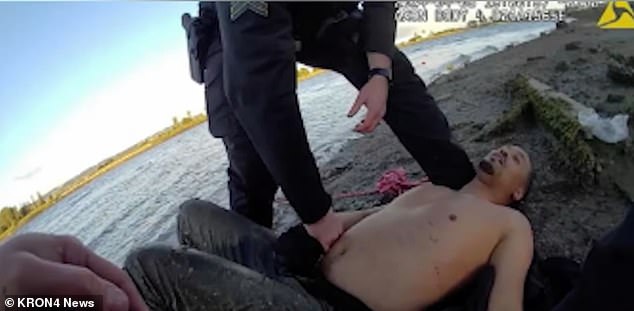Shocking body camera footage captured the moment an Oakland police officer shot an unarmed father of two with a Taser as he struggled in the water.
Deontae Faison, 35, was initially charged with driving with expired tags on his vehicle on April 5, 2024, before the incident that left him in a coma and prompted his family to file a federal lawsuit.
East Bay Officer Jonathan Knea has been charged with violating district policy and Taser manufacturing guidelines after he was seen on body camera footage deploying his stun gun and shooting Faison as he struggled in an estuary. , according to the San Francisco Standard.
The incident began when Faison and a white friend grabbed some food at a local Wendy’s, where Knea first discovered that the truck had expired tags.
Deontae Faison, 35, a father of two, has not been responsive since East Bay Officer Jonathan Knea shot him with a stun gun on April 5, 2024.
Faison and his friend then traveled to the park to eat, where Knea confronted them.
In the body camera footage, the officer could be seen pointing a gun at Faison, who raised his hands as Knea told him to get out of the vehicle and sit on the bumper.
Knea then asked him about the expired tags, but Faison told him he was not driving the car and gave the officer a false name.
He had felt like he was being treated differently than his white friend, who, according to the lawsuit, was not asked anything even though she owned the car and also provided a false identity. Reports on law and crimes.
The lawsuit claims Faison began to become agitated about being “harassed in the park” for approximately 20 minutes while Knea interrogated him and searched Faison’s alias in the Alameda County database, for which he found no results.
The officer then called for backup and threatened to ask a fingerprint technician to identify him, and Faison “feared for his life,” according to the lawsuit.

Body camera footage of the incident showed Faison with his hands up inside a truck as Officer Knea pulled out a gun and told him to get out of the vehicle.

Knea continued to deploy the Taser as Faison waded through knee-deep water, leaving the cord attached to Faison’s back.
He then began running towards the estuary as Knea shouted at him to “get down” and stop running.
The officer was then seen pointing the Taser at him.
The officer then deployed the stun gun on Faison’s back from a distance, without “any announcement and without establishing any communication,” the lawsuit says.
Faison then collapsed, but managed to fall into the estuary.
When he was almost knee-deep, the lawsuit says, Knea redeployed the Taser until he drained the battery, leaving the cord attached to Faison’s back.
The victim then struggled in the water for more than 30 minutes calling for help, according to the lawsuit, before falling face-first into the estuary and beginning to take on water.
He then lost consciousness and floated to the opposite shore, where officers dragged his body ashore.
But in the approximately 17 minutes before paramedics arrived, police did not administer CPR and did not tell paramedics that Faison had been Tasered, the lawsuit states. according to the San Francisco Chronicle.

Faison lost consciousness and floated to the opposite shore, where officers dragged his body ashore.
An Alameda County sheriff’s deputy, who was called to the scene, later noted that Faison was in the water for nearly 40 minutes.
He also noted that officers attempted to call Oakland police, firefighters and the Coast Guard for help, but “no water rescue resources were available” at the time.
The lawsuit also says Knea “failed to communicate to hospital staff” that Faison had been stunned multiple times “in an attempt to conceal the true nature of what happened to him and promote the false narrative that Deontae had simply drowned.”
Hospital staff only learned he had been Tasered the day after his admission, when medical staff discovered puncture wounds from the device.
“When they saw him flailing, trying to avoid drowning, pleading for his life and help, these people sat casually on the beach watching him as if he were some kind of entertainment or amusement,” the civil rights spokesman said. Lawyer Adanté Pointer said at a press conference on Tuesday: Mercury News reports.
“The officers’ deliberate indifference to Deontae’s life is appalling,” Pointer said. “They stood there for over half an hour watching him fight for his life.”

Faison now still requires the use of a feeding tube and is unable to move his eyes or limbs.
The lawsuit, filed against police officer Jonathan Knea, the East Bay Regional Park District and Alameda County, now claims that Knea violated department policy by using a Taser on a person who is in water, particularly water salty, due to its conductivity.
Tasers can cause pain, loss of muscle control, elevated heart rate, and breathing difficulties.
But the East Bay Regional Park District only discourages – not strictly prohibits – police officers from using a Taser “on persons whose position or activity could result in collateral injury,” including people “located in water,” according to KTVU.
He also accuses officers at the scene of lying in their report that Faison was armed at the time, and claims that officers hid evidence by turning off body camera audio and discarding Taser components and Faison’s clothing.
The lawsuit further claims that Knea knew his use of the Taser was endangering Faison, and even verbally said, “He’s not going to make it.”

His family said he was unable to attend his son’s high school graduation and 18th birthday.
But police have previously claimed that Faison is a convicted felon who had a warrant out for his arrest.
Court records obtained by Mercury New show he was on probation after pleading no contest in a 2021 robbery case, but that probation appears to have been revoked in early 2023.
It is unclear whether it remained revoked when Knea confronted Faison that day.
Still, Pointer told KTVU that Knea didn’t know anything about Faison’s story when he pulled him over and said the officer “escalated this situation.”
“It’s either submit or die,” he said. “They used life-threatening force for a minor traffic stop.”
Faison now still requires the use of a feeding tube and is unable to move his eyes or limbs, according to Mercury News.
His oldest son, also named Deontae, turned 18 in June and graduated from high school, but his father wasn’t there to see him.
‘His father has never missed a graduation. His father has never missed a birthday. On one of the biggest birthdays, on one of the biggest celebrations, he wasn’t there and it’s not fair,” said the boy’s mother, Teyona Davis.
“I can’t even trust the people who are supposed to protect my son, because look what they did to his father.”
The younger Deontae added that his father’s coma “just derailed all of our lives.”
‘I can’t go to the park. I can’t play basketball. “It’s very hard for all of us,” he said.


